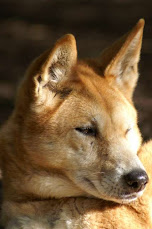




The Dwarf Blue Sheep or Dwarf Bharal Pseudois schaeferi is an endangered species of caprid found in China Proper and Tibet. It inhabits low, arid, grassy slopes of the upper Yangtze gorge in Batang County of the Sichuan Province, and a small part of the Tibet Autonomous Region, where it is known by the local name Rong-na.
Originally given subspecific status to the Bharal (Pseudois nauyar), morphological research conducted in the 1970s led it to be considered a distinct species. However recent molecular analysis has shown the difference between the two species is slight, and suggests it should be treated as a subspecies of the Bharal.
The Dwarf Blue Sheep differs from the Bharal primarily in size, with adult males weighing around 35kg, half as much as the Bharal. Less sexual dimorphism occurs in this species, and females of the two species are very similar. Its coat is a steely grey with a silvery sheen, with darker general colouration than the Bharal, and the horns of the male are smaller, thinner and more upright, with no inward curl.
In 2000 there were estimated just 200 individuals of Dwarf Blue Sheep alive. The species is hunted, and in their limited range cannot escape from humans and livestock. Although a reserve of 142.4 square km was set up around Zhubalong in 1995, human activities continue to go on there.




































